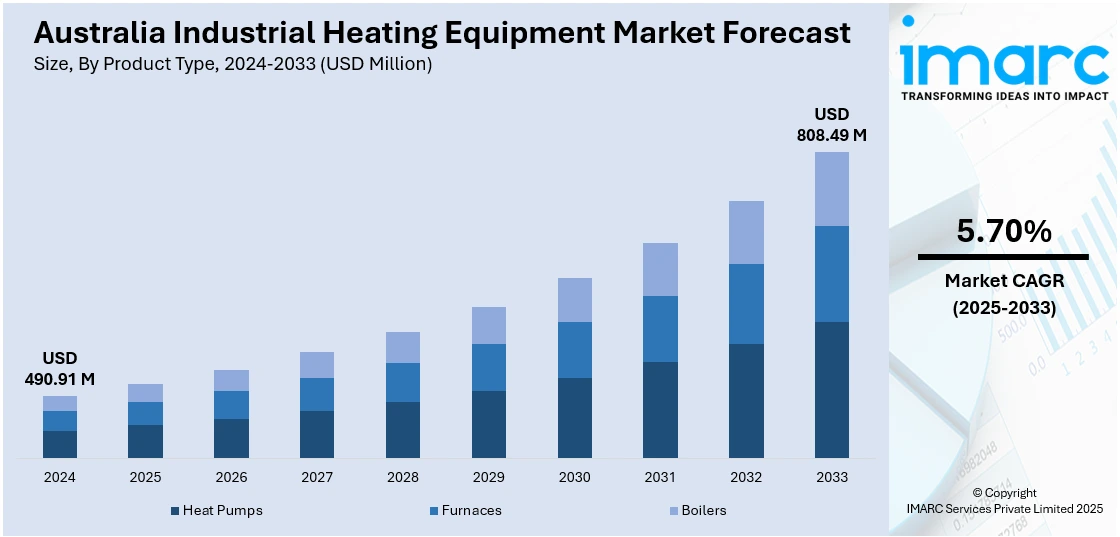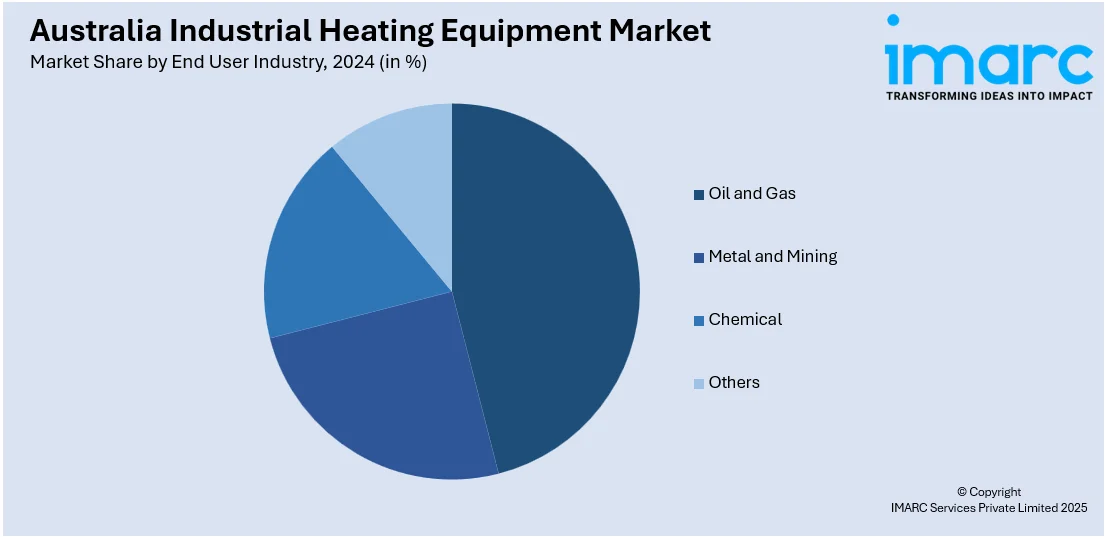
Australia Industrial Heating Equipment Market Size, Share, Trends and Forecast by Product Type, Fuel Type, End User Industry, and Region, 2025-2033
Australia Industrial Heating Equipment Market Overview:
The Australia industrial heating equipment market size reached USD 490.91 Million in 2024. Looking forward, IMARC Group expects the market to reach USD 808.49 Million by 2033, exhibiting a growth rate (CAGR) of 5.70% during 2025-2033. With Australian industries striving for sustainability and cost efficiency, the need for heating equipment integrated with AI is rising. Besides this, the increasing execution of government policies and incentives, which are encouraging clean energy use, is contributing to the expansion of the Australia industrial heating equipment market share.
|
Report Attribute
|
Key Statistics
|
|---|---|
|
Base Year
|
2024
|
|
Forecast Years
|
2025-2033
|
|
Historical Years
|
2019-2024
|
| Market Size in 2024 | USD 490.91 Million |
| Market Forecast in 2033 | USD 808.49 Million |
| Market Growth Rate 2025-2033 | 5.70% |
Australia Industrial Heating Equipment Market Trends:
Growing adoption of renewable energy
The market's expansion is being supported by the growing use of renewable energy. According to the 2024 Clean Energy Council study, renewable energy sources accounted for about 40% of Australia's electricity. Industries are looking for heating systems that work with renewable energy sources like solar, wind, and bioenergy as more of them transition to these sources. In response, producers of industrial heating equipment are creating systems that can incorporate renewable energy sources, such solar or wind-powered electric heaters. Australia's national objectives to reduce carbon emissions and promote environmentally friendly industrial practices are being supported by this trend. Renewable-oriented heating is also being used by businesses to save long-term energy expenses and obtain environmental certifications that enhance their reputation in the marketplace. The need for energy-efficient and environmentally friendly heating solutions is only increasing as a result of government policies and incentives that promote the use of clean energy. Advanced heating technologies that function well with fluctuating power sources are frequently needed for the integration of renewable energy, which drives advancements in the heating equipment industry. These technologies are helping industries like agriculture and food processing, particularly in isolated locations where renewable energy may be more readily available than conventional fuels. The growing emphasis on attaining energy security and reducing reliance on fossil fuels is supporting market expansion.

To get more information on this market, Request Sample
Increasing integration of AI
The rising integration of AI is propelling the Australia industrial heating equipment market growth. AI enhances operational efficiency by enabling predictive maintenance, which reduces downtime and extends equipment life. It allows manufacturers to monitor performance in real-time and adjust heating processes automatically for better energy efficiency. AI-based systems can analyze large sets of data to optimize temperature control, leading to improved product quality and minimized waste. This smart automation reduces the need for manual intervention, lowering labor costs and human errors. As industries in Australia are aiming for sustainability and cost-effectiveness, the demand for AI-integrated heating equipment is increasing. Sectors, such as food processing, chemicals, and metal manufacturing, are benefiting from AI’s ability to streamline operations and ensure consistent heating outcomes. Moreover, AI aids in meeting strict safety and environmental regulations by monitoring emissions and alerting operators to potential hazards. As digital transformation is accelerating across industries, companies are investing in AI-enabled heating solutions to stay competitive. This shift towards high AI usage is encouraging innovations in the market. As per industry reports, the Australia AI market is set to attain USD 8.89 Billion by 2029.
Australia Industrial Heating Equipment Market Segmentation:
IMARC Group provides an analysis of the key trends in each segment of the market, along with forecasts at the country and regional levels for 2025-2033. Our report has categorized the market based on product type, fuel type, and end user industry.
Product Type Insights:
- Heat Pumps
- Furnaces
- Boilers
The report has provided a detailed breakup and analysis of the market based on the product type. This includes heat pumps, furnaces, and boilers.
Fuel Type Insights:
- Fossil Fuel
- Electric
A detailed breakup and analysis of the market based on the fuel type have also been provided in the report. This includes fossil fuel and electric.
End User Industry Insights:

- Oil and Gas
- Metal and Mining
- Chemical
- Others
The report has provided a detailed breakup and analysis of the market based on the end user industry. This includes oil and gas, metal and mining, chemical, and others.
Regional Insights:
- Australia Capital Territory & New South Wales
- Victoria & Tasmania
- Queensland
- Northern Territory & Southern Australia
- Western Australia
The report has also provided a comprehensive analysis of all the major regional markets, which include Australia Capital Territory & New South Wales, Victoria & Tasmania, Queensland, Northern Territory & Southern Australia, and Western Australia.
Competitive Landscape:
The market research report has also provided a comprehensive analysis of the competitive landscape. Competitive analysis such as market structure, key player positioning, top winning strategies, competitive dashboard, and company evaluation quadrant has been covered in the report. Also, detailed profiles of all major companies have been provided.
Australia Industrial Heating Equipment Market News:
- In April 2025, MGA Thermal, and Australian startup, announced that it finished the world's first industrial steam heat energy storage demonstration. The project involved MGA Thermal using its electro-thermal energy storage (ETES) system to accumulate 5MWh of energy, featuring a thermal dispatch power of 500kW. This system provided uninterrupted superheated steam for 24 hours.
- In July 2024, the Energy Efficiency Council published the roadmap for Heat Pump Hot Water Systems in Australia. The NSW government collaborated with industry to cultivate the skills and resources essential for a safe, sustainable, and high-quality implementation of vital low-emissions technology.
Australia Industrial Heating Equipment Market Report Coverage:
| Report Features | Details |
|---|---|
| Base Year of the Analysis | 2024 |
| Historical Period | 2019-2024 |
| Forecast Period | 2025-2033 |
| Units | Million USD |
| Scope of the Report |
Exploration of Historical Trends and Market Outlook, Industry Catalysts and Challenges, Segment-Wise Historical and Future Market Assessment:
|
| Product Types Covered | Heat Pumps, Furnaces, Boilers |
| Fuel Types Covered | Fossil Fuel, Electric |
| End User Industries Covered | Oil and Gas, Metal and Mining, Chemical, Others |
| Regions Covered | Australia Capital Territory & New South Wales, Victoria & Tasmania, Queensland, Northern Territory & Southern Australia, Western Australia |
| Customization Scope | 10% Free Customization |
| Post-Sale Analyst Support | 10-12 Weeks |
| Delivery Format | PDF and Excel through Email (We can also provide the editable version of the report in PPT/Word format on special request) |
Key Questions Answered in This Report:
- How has the Australia industrial heating equipment market performed so far and how will it perform in the coming years?
- What is the breakup of the Australia industrial heating equipment market on the basis of product type?
- What is the breakup of the Australia industrial heating equipment market on the basis of fuel type?
- What is the breakup of the Australia industrial heating equipment market on the basis of end user industry?
- What is the breakup of the Australia industrial heating equipment market on the basis of region?
- What are the various stages in the value chain of the Australia industrial heating equipment market?
- What are the key driving factors and challenges in the Australia industrial heating equipment market?
- What is the structure of the Australia industrial heating equipment market and who are the key players?
- What is the degree of competition in the Australia industrial heating equipment market?
Key Benefits for Stakeholders:
- IMARC’s industry report offers a comprehensive quantitative analysis of various market segments, historical and current market trends, market forecasts, and dynamics of the Australia industrial heating equipment market from 2019-2033.
- The research report provides the latest information on the market drivers, challenges, and opportunities in the Australia industrial heating equipment market.
- Porter's five forces analysis assist stakeholders in assessing the impact of new entrants, competitive rivalry, supplier power, buyer power, and the threat of substitution. It helps stakeholders to analyze the level of competition within the Australia industrial heating equipment industry and its attractiveness.
- Competitive landscape allows stakeholders to understand their competitive environment and provides an insight into the current positions of key players in the market.
Need more help?
- Speak to our experienced analysts for insights on the current market scenarios.
- Include additional segments and countries to customize the report as per your requirement.
- Gain an unparalleled competitive advantage in your domain by understanding how to utilize the report and positively impacting your operations and revenue.
- For further assistance, please connect with our analysts.
 Request Customization
Request Customization
 Speak to an Analyst
Speak to an Analyst
 Request Brochure
Request Brochure
 Inquire Before Buying
Inquire Before Buying




.webp)




.webp)












